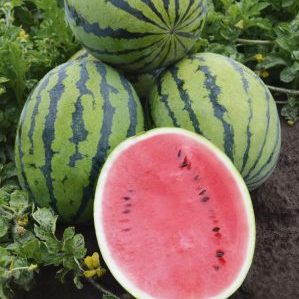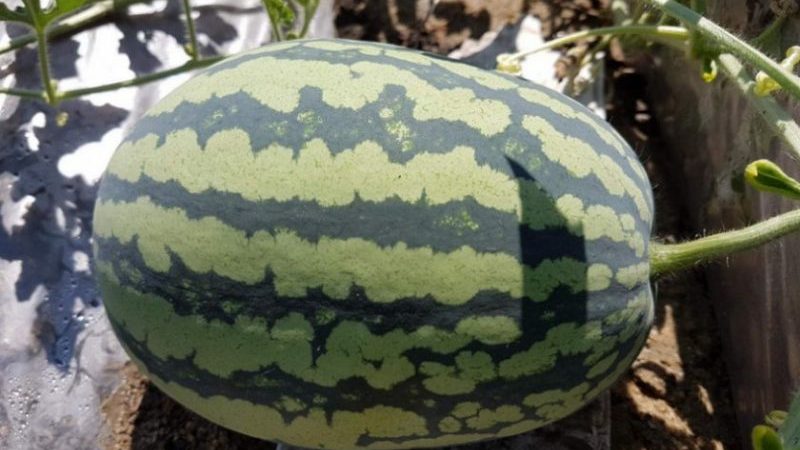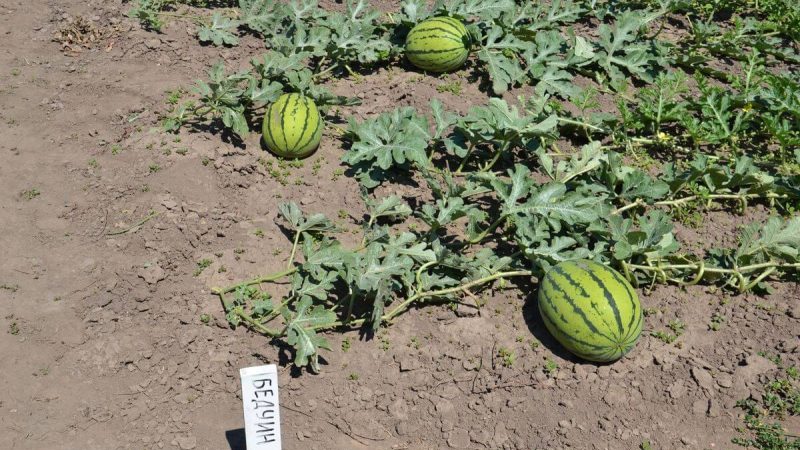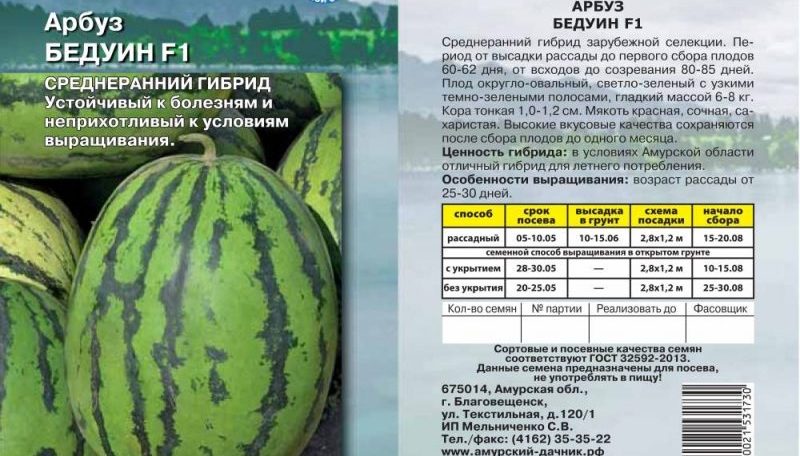An unpretentious in care ultra-early watermelon "Bedouin f1" for central Russia
Watermelons have always been considered an ideal summer treat, but for a long time they were grown only in the southern regions, where there is a lot of heat and light. However, breeders managed to breed several hybrids of this culture, which grow in temperate climates, and in film-covered greenhouses - even in Siberia. They are distinguished by good yield and taste. Watermelon Bedouin F1 is one such crop.
The content of the article
Description
The hybrid was bred by breeders of the Dutch company Bejo Zaden. The firm is traditionally engaged in the selection of vegetables, paying special attention to their regionalization.
The most successful developments of the company are aimed at cultivating 3 factors:
- resistance to known diseases;
- improving the taste and appearance of the culture;
- increased productivity.
All this was achieved to a certain extent when the Bedouin hybrid was developed.
The photo shows the fruits of the Bedouin.

Distinctive features
The hybrid is characterized by early ripening (80 days), disease and pest resistance, and a characteristic sweet taste.
Important! The main advantage of the hybrid is its ability to grow in unfavorable temperature conditions.
Seeds are sown in open ground, when the ground warms up to a temperature of + 15 ... + 16 ° C, they are able to germinate even in such conditions. However, it is better to cover seedlings with film material.
Composition, properties, benefits, calories
Almost any watermelon is 90% water, hybrids are no exception. But the remaining 10% contains many valuable and useful substances for the human body.
By the amount of vitamins and minerals, the composition of this large berries impressive:
- it contains vitamins of groups A, B, C, E, H and PP;
- watermelon is traditionally high in calcium, magnesium and iron;
- it contains phosphorus and sodium.
Dietary fibers, which make up the pulp of watermelon, stimulate the elimination of harmful substances from the body, accelerate metabolic processes in general, cleanse the kidneys, bile ducts from small stones and sand. Such a complete cleansing can be successfully done in 1 summer season.
Regular consumption of watermelons significantly lowers blood cholesterol levels and prevents the formation of plaques in the vessels, which cause numerous diseases of the cardiovascular system.
Calorie content of watermelons varieties Bedouin is close to the traditional one and is 25 kcal per 100 g of consumed product.
Attention! Watermelons contain a lot Sahara, so doctors recommend that people with diabetes mellitus use the berry with caution and in small quantities. The same applies to patients with renal failure.
The sugar content of the pulp of this hybrid is close to 13%.
Characteristics of bushes and fruits
Another distinctive quality of the hybrid is the powerful, vigorous development of the bush and lashes, even in adverse weather conditions.
The yield does not fall when the planting site thickens, therefore, in farms it is permissible to plant up to 7,000 plants per hectare.

Fruit characteristics:
- oval shape;
- brindle color - light green stripes interspersed with dark ones;
- the thickness of the peel is 12-13 mm, this figure is considered average;
- the hybrid is resistant to fusarium - the main misfortune of melons and gourds;
- long keeping quality.
The pulp of these watermelons is juicy, red, crunchy, and has all the valuable flavoring qualities that are inherent in this culture.
The Bedouin hybrid is suitable for fresh consumption, for salting for winter and for cooking jam and candied fruits.
3 fruits are usually formed on one lash. The average weight of each of them is 9-10 kg.
Seeds of watermelon
For gourmets, the hybrid will be attractive in that the seeds of such watermelons are small, there are few of them. However, they cannot be used for subsequent cultivation. Second-generation hybrids grow less viable, are susceptible to disease, and the taste of their fruit acquires a herbal character with a noticeable decrease in sweetness.
Therefore, planting material should be purchased in specialized stores in appropriate packaging. They are sold in bags (5-10 pcs.) Or in cassettes, where they are packed in 40-50 pcs.
How to grow yourself
The seedling method of growing is especially effective in regions with a temperate climate, where the soil finally warms up only by the end of May. Indoors, seeds of the Bedouin hybrid for seedlings can and should be planted at the end of April.
Growing in stages and care
Since the root system of melons and gourds hybrids is sensitive, it is better not to pick the crop, but to plant the prepared seeds in peat pots or plastic cups. The soil is prepared in the form of a mixture of garden soil, leaf humus and sand, and the latter should be slightly more than the other components, the watermelon loves it.
The optimum temperature for growing is around 25 ° C. However, germination can begin as early as 18 C.
Cups or pots are recommended to be placed on windowsills on the south side, no illumination is required. There is only 1 indispensable condition: the leaves of seedlings from neighboring containers should not touch each other, otherwise they may wither - this is a feature of all melons and gourds.
The hybrid is planted in open ground in late May - early June. Then the crop can be harvested at the end of July - beginning of August.
Before planting, the beds are prepared by filling them with compost. It is recommended to plant 2 sprouts on one ridge on both sides, directing their lashes in opposite directions.
Planting with seeds is recommended in the southern regions when the soil warms up to 15 ° C. If fertilizers were not applied to the site in the fall, it is advisable to add 1 tsp to each planting hole. ammofoski, 1 tbsp. l. ash and humus. After that, water is poured into the hole, waiting for soaking and 2-3 seeds are placed in it, a little distant from each other. Re-watering is not required.
The first shoots appear in a week. When the first 4 true leaves appear, you can thin out the shoots, leaving the most viable specimens.
Water on hot days and during the flowering period. In general, 3 abundant watering is done during the season:
- after the formation of 6 full leaves;
- during full-color flowering;
- at the beginning of fruit formation.
In these cases, you should not spare the water, water the entire area, even the aisles. The next day, it is recommended to carry out high-quality loosening and weeding.
When the fruits are finally formed, watering is stopped.
The first feeding is done 2 weeks after planting the seedlings in open ground. The second is when setting fruit.
A solution of ammonium nitrate or chicken droppings is used as the basis for feeding.
Features of cultivation and possible difficulties
The main difficulty in growing these watermelons is the timely and correct formation of the bush. Since the stem of the Bedouin grows vigorously, it must be pinched after the formation of 3 fruits on the bush the size of a hen's egg.
Lateral shoots and stepchildren are shortened, starting with the lower ones.
Another feature: if the fruits, when ripe, lie on the ground, they can begin to rot or become infected with diseases.If the plantation is small, it is recommended to put small sheets of plywood under each fruit.
Disease and pest resistance
Despite a certain resistance to diseases, this hybrid can be affected by diseases:
- powdery mildew is visible on the white bloom on the leaves and rotting of the fruit;
- peronosporosis affects the leaves and slows down or even stops the growth of fruits;
- olive spot affects ovaries;
- angular spotting forms oil spots and holes on the leaves;
- anthracnose causes the whole bush to dry out;
- brown rot destroys roots;
- the cucumber mosaic forms a mosaic pattern on the leaves, after which the plant dies.
Of the pests, watermelons are often attacked by wireworms, melon aphids and winter moths appear, which gnaw the roots of the plant.
Diseases are treated with chemicals and Bordeaux liquid.
Important! Cucumber mosaic cannot be treated, the affected bushes should be immediately destroyed.
Pests are afraid of a solution of potassium permanganate, a decoction of tobacco leaves or ash.
Harvesting and application of the crop
Harvested early in maturity. Unripe can ripen for a long time outside melons, but overripe are not stored for long. Watermelons, picked in a timely manner, are kept in presentation for 45 days.
They are used fresh, pickled, preserves and jams.
Advantages and disadvantages

This hybrid has many advantages:
- watermelon has excellent traditional taste;
- easy to transport;
- resistant to disease;
- tolerates temperature extremes;
- a lot of sugar accumulates in fruits;
- the presentation of the product is quite attractive;
- dense planting in a limited area does not reduce the yield of this hybrid.
Minus conditional: every season it is necessary to purchase new seeds, and they are relatively expensive, you cannot use your own seed material for a full harvest.
Reviews
All gardeners who have invested time and effort in high-quality plant care speak positively about the Bedouin hybrid.
Matvey, Rostov: "My previous experience of growing watermelons in my summer cottage was not fun - if the fruits ripened, then they are very small. Once a neighbor saw a Bedouin, became interested, tried to buy seeds himself. In the first season, too, nothing came of it: I had no idea about the timing of watering and about the diseases of melons. I had to read something, listen to advice. And now this hybrid is one of the most beloved in our family. There is no need to compare with imported watermelons, ours are better. "
Igor, Belgorod: “I grow melons in the South Urals. There is a lot of sunshine here in the summer, but the differences in day and night temperatures are noticeable. Not all watermelons can handle them. But this hybrid is hardy, tasty, and retains its presentation for a long time. He is willingly taken for sale in retail outlets. This culture suits me. "
Conclusion
The appearance of the Bedouin F1 and similar hybrids on the market made it possible to grow watermelons in the open field in those regions of Russia in which these fruits were not previously cultivated. The hybrid is unpretentious, grows actively, tastes sweet and juicy. Lovers of melons can safely recommend it.